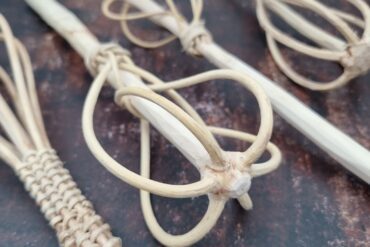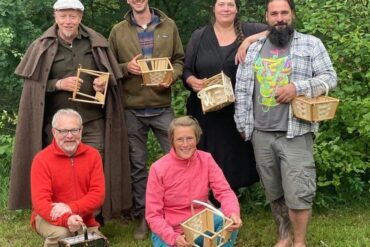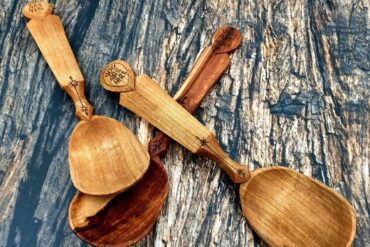It is a little known basket type in the Netherlands, so you may not have heard about it before: the Swedish knutkorg, or knot basket in English.
A few weeks ago I had the unique opportunity to co-organize and follow a knutkorg course in the Netherlands with Fred Livesay, a fresh wood teacher from the US who is currently researching this exciting way of making baskets. Because it is a very nice way of fresh woodworking, about which little knowledge can be found, I will share a few things worth knowing in this blog. It’s a really fun technique to try!



What is a Knutkorg?
A knutkorg is a basket with a curved frame that keeps itself under tension. The frame consists of 4 u-shapes that interlock. The side walls are later filled with corner panels, stakes and weavers. When all side panels are woven is the basket will become rigid and robust. It is therefore quite an art to put the basket together and keep it that way.
Knutkorg is a Swedish word meaning knot (knut) basket (korg). In Norwegian, the basket is also called a ‘sendingskorg’ with a curved frame. Sending (send) and korg (basket), so it literally means a basket to send stuff in. In practice, the baskets were used to transport presents, with the basket itself being part of the gift. Personally, I like the name knot basket because it refers to a structural part of the basket, namely the knobs (knots) that sit at the corners of the frame and keep the basket from falling apart. So literally a kind of knot.
Where were the baskets made?
The oldest known basket is about 200 years old. The baskets were mainly made in parts of Norway, Sweden and Finland. The craft probably came from Finland with migrant workers to Minnesota in the US sometime in the last century. This is where Fred Livesay, a teacher at the North House Folk School and the Vesterheim Museum, came into contact with these baskets. He became fascinated with them and began to delve into their history and started making them himself.
Tricks of the trade
Fred received a research fellowship from the American Scandinavian Foundation to further research, teach and safeguard this craft. He traveled to one of the last teachers in Sweden still practicing this craft, Göran Andersson. From him he learned the tricks of the trade. Fred is currently traveling through Europe to teach and safeguard this craft in a number of places. He made room in his tight travel schedule to teach this technique in the Netherlands at the beautiful location of Jan Harm ter Brugge (Hout van bomen). This was the first time this technique was taught in the Netherlands. A unique opportunity to learn this craft personally from an expert instead of rediscovering it from books or examples.



Making a basket
Under the professional guidance of Fred, we made this basket with a small group in just over 2 days. And that was quite a job. Because in the past, the harvesting and pre-processing of the materials and the final construction would not have been done all in one go. Often it was a process throughout the seasons, which we have now walked through at an accelerated pace. The frame is made from fresh willow branches that are bent, after which the frame is allowed to dry. The same applies to the splitting and finishing of the spruce/pine frames and willow weavers. Only when everything is dry can the construction begin. The basket is therefore a combination of fresh and dry woodworking. To realize all this in one weekend requires some creativity…
Quite a challenge
Putting together such a basket is quite a challenge. Bending the wood without breaking or tearing it out, symmetry, but especially tailoring and placing the corner panels and stakes was quite a job because there is so much movement in the frame while on the other hand everything has to be put under tension. On the one hand you need that slack to get everything in place and on the other hand the slack ensures that everything comes loose just as easily. Finding the right size, so that you can still get the stakes in, but that they don’t keep flying around is still quite a job. Especiliallly so for beginner such as myself.
After the umpteenth time everything fell apart again, I started to lose hope a bit. I had already tried everything. Such as making the frame more rigid by temporarily tying it with rope or making the grooves deeper, re-carving the stakes and so on. It just didn’t work and time was running out. So I decided to change the design of my basket slightly from 3 intermediate stakes to 1. This put less tension on the stakes and they stayed in place, so that I still managed to finish the basket within the weekend. A real moment of victory!



A booklet is in the making!
It is difficult to get background literature on making these baskets. The information available is in Scandinavian and is not or hardly available. Fred is currently working with a number of others on an English instructional booklet on making knutkorgar along with a history and photo’s. It will be a release that I, and many with me, are really looking forward to!
Masters of Sloyd
With the arrival of the ‘modern era’, the appreciation for crafts has declined enormously, at least this was so in the Netherlands. The number of practitioners of crafts is very minimal or has even disappeared completely for a period. Fortunately, in recent years there has been a significant revival in the appreciation and interest in these types of old crafts. The number of practitioners is increasing and together we are rediscovering knowledge and techniques and the craft continues to develop. It is so important to continue to transfer and thereby safeguard this knowledge. Only in this way does it remain a living craft.
What I am very happy about is that Fred has committed to give an online webinar for a new series Masters of Sloyd next winter! If the book isn’t out by then, it offers an unique opportunity to hear Fred himself out about these great baskets. Same goes if the book is released by then… A date for this webinar has yet to be planned, so keep an eye on the website and my social media!


